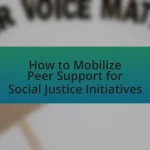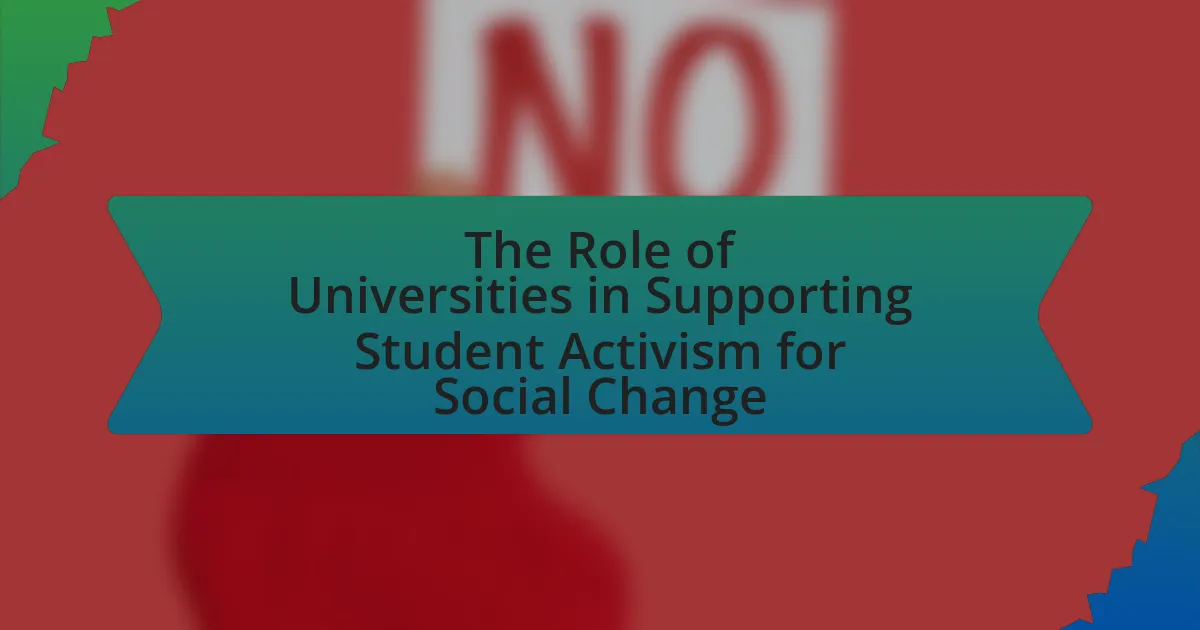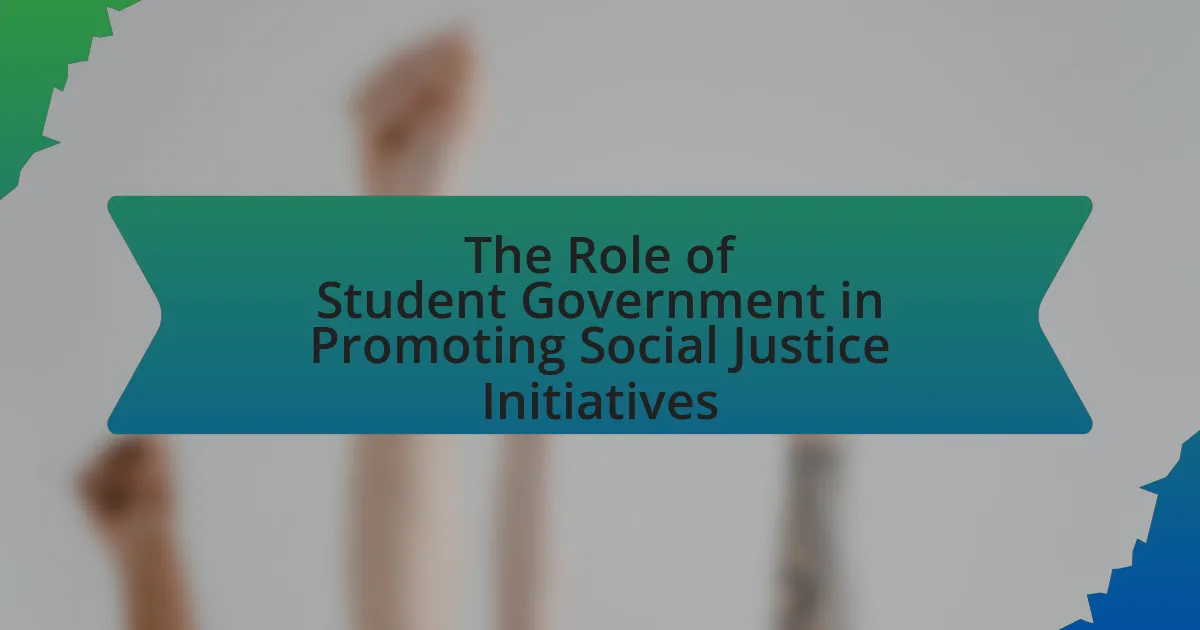The article focuses on the challenges faced by student activists in navigating institutional barriers, which include administrative resistance, lack of funding, restrictive policies, and limited access to resources. It examines how these barriers impact student engagement and participation, leading to diminished motivation and disillusionment with the educational system. The article also outlines strategies for identifying and overcoming these barriers, emphasizing the importance of coalition-building, effective communication, and persistence. Additionally, it highlights the role of student feedback and alliances with faculty and administration in fostering a supportive environment for activism.
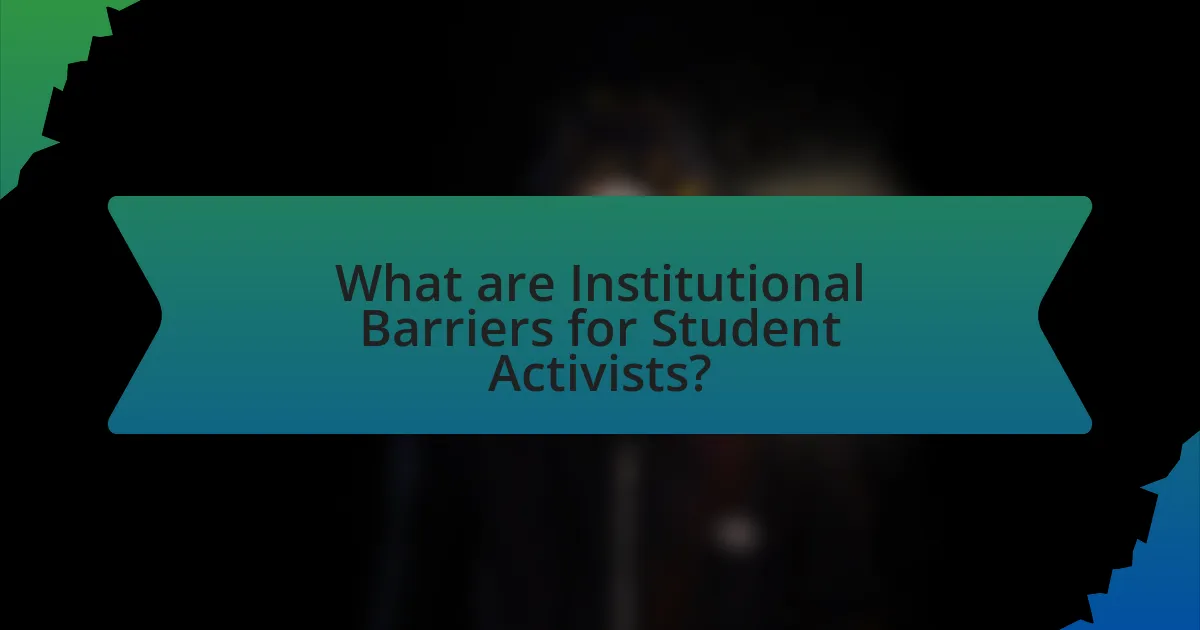
What are Institutional Barriers for Student Activists?
Institutional barriers for student activists include administrative resistance, lack of funding, restrictive policies, and limited access to resources. Administrative resistance often manifests as pushback from university officials who may view activism as disruptive, leading to a stifling of student voices. Lack of funding can hinder the ability to organize events or campaigns, as many institutions do not allocate sufficient resources for student-led initiatives. Restrictive policies, such as regulations on protests or the use of campus facilities, can further limit the effectiveness of activism. Limited access to resources, including information and support networks, can isolate student activists and impede their efforts to mobilize peers. These barriers collectively create an environment that challenges the ability of student activists to effect change within their institutions.
How do institutional barriers impact student activism?
Institutional barriers significantly hinder student activism by limiting access to resources, restricting freedom of expression, and imposing bureaucratic obstacles. These barriers can manifest as administrative policies that require permits for protests, limitations on meeting spaces, or restrictions on funding for student organizations. For instance, a study by the American Association of University Professors found that 60% of student activists reported facing administrative pushback when attempting to organize events or protests, illustrating how institutional policies can stifle student voices and activism efforts.
What types of institutional barriers do student activists face?
Student activists face several types of institutional barriers, including administrative resistance, lack of funding, and restrictive policies. Administrative resistance often manifests as pushback from university officials who may view activism as disruptive, leading to limited support for initiatives. Lack of funding can hinder student-led projects, as many institutions allocate minimal resources for activism-related activities. Additionally, restrictive policies, such as those governing free speech or assembly, can limit the ability of student activists to organize and express their views effectively. These barriers collectively impede the efforts of student activists to effect change within their institutions.
Why do these barriers exist within educational institutions?
Barriers exist within educational institutions primarily due to systemic inequalities and institutional policies that prioritize certain demographics over others. These barriers can manifest as limited access to resources, discriminatory practices, and bureaucratic obstacles that hinder student engagement and participation. For instance, research by the National Center for Education Statistics indicates that students from marginalized backgrounds often face higher dropout rates and lower access to advanced coursework, highlighting the disparities in educational opportunities. Additionally, institutional inertia and resistance to change can perpetuate these barriers, making it difficult for student activists to advocate for equitable reforms.
What are the consequences of institutional barriers on student activism?
Institutional barriers significantly hinder student activism by limiting access to resources, stifling free expression, and creating an environment of fear and repression. These barriers, such as restrictive policies, lack of administrative support, and inadequate funding, can lead to decreased student engagement and participation in activism. For instance, a study by the American Association of University Professors found that 60% of students reported feeling discouraged from expressing their views due to institutional constraints. This suppression not only diminishes the effectiveness of student-led initiatives but also undermines the overall democratic process within educational institutions.
How do these barriers affect student engagement and participation?
Barriers such as financial constraints, lack of access to resources, and institutional resistance significantly hinder student engagement and participation. These obstacles create an environment where students feel marginalized and unable to contribute effectively to activism. For instance, a study by the National Student Clearinghouse Research Center found that financial difficulties lead to a 30% decrease in student involvement in extracurricular activities, including activism. Additionally, when institutions impose bureaucratic hurdles, such as requiring extensive approvals for events, student participation often declines due to frustration and perceived futility. Thus, these barriers directly correlate with reduced student engagement and participation in activist efforts.
What long-term effects can institutional barriers have on student activists?
Institutional barriers can lead to long-term effects on student activists, including diminished motivation, reduced participation in future activism, and a sense of disillusionment with the educational system. These barriers often create an environment where student voices are marginalized, leading to feelings of isolation and frustration. Research indicates that when students face obstacles such as administrative pushback or lack of support, their likelihood of engaging in activism decreases over time, as evidenced by studies showing a correlation between institutional resistance and lower rates of sustained student engagement in social movements. Additionally, prolonged exposure to these barriers can foster a belief that systemic change is unattainable, which can hinder the development of critical leadership skills and reduce the overall impact of student activism on campus culture.

How can Student Activists Identify Institutional Barriers?
Student activists can identify institutional barriers by conducting thorough research on policies, practices, and historical contexts within their institutions. This involves analyzing official documents, such as student handbooks and institutional reports, to uncover regulations that may hinder student engagement or activism. Additionally, gathering qualitative data through surveys and interviews with fellow students can reveal personal experiences and perceptions of barriers. For instance, a study by the American Association of University Professors found that 60% of students reported feeling restricted by administrative policies when attempting to organize events. By combining quantitative and qualitative methods, student activists can effectively pinpoint specific institutional barriers that impede their efforts.
What strategies can student activists use to recognize barriers?
Student activists can use strategies such as conducting surveys, engaging in dialogue with diverse student groups, and analyzing institutional policies to recognize barriers. Surveys can provide quantitative data on student experiences, highlighting specific obstacles faced by different demographics. Engaging in dialogue fosters a deeper understanding of the unique challenges various groups encounter, while analyzing institutional policies reveals systemic issues that may not be immediately visible. These methods are supported by research indicating that inclusive approaches to data collection and community engagement enhance awareness of barriers within educational institutions.
How can students assess their institution’s policies and practices?
Students can assess their institution’s policies and practices by conducting surveys, reviewing official documents, and engaging in discussions with administration and faculty. Surveys can gather student opinions on various policies, while reviewing documents such as handbooks and policy statements provides insight into institutional guidelines. Engaging in discussions allows students to clarify ambiguities and understand the rationale behind certain practices. Research indicates that active student participation in policy assessment can lead to more transparent and responsive governance, as seen in studies conducted by the National Student Affairs Association, which highlight the importance of student feedback in shaping institutional policies.
What role does student feedback play in identifying barriers?
Student feedback plays a crucial role in identifying barriers by providing direct insights into the challenges faced by students within an institution. This feedback allows administrators and educators to understand specific issues, such as inadequate resources, lack of support services, or ineffective communication channels. For instance, a study by the National Survey of Student Engagement found that institutions that actively solicit and act on student feedback see improved student satisfaction and retention rates, indicating that addressing identified barriers leads to a more supportive educational environment.
How can student activists gather support to address barriers?
Student activists can gather support to address barriers by organizing awareness campaigns that highlight specific issues and mobilize peers. These campaigns can include social media outreach, informational events, and collaboration with existing student organizations to amplify their message. For instance, a study by the National Student Activism Coalition found that coordinated efforts among student groups led to a 30% increase in participation in advocacy initiatives. By leveraging platforms like social media, student activists can reach a wider audience, engage in dialogue, and foster a sense of community around shared goals, ultimately increasing their influence and effectiveness in addressing institutional barriers.
What methods can be used to mobilize fellow students?
To mobilize fellow students, effective methods include organizing events, utilizing social media, and forming coalitions. Organizing events such as rallies, workshops, or informational sessions can create a sense of community and urgency around specific issues. Utilizing social media platforms allows for rapid dissemination of information and engagement with a broader audience, facilitating discussions and encouraging participation. Forming coalitions with existing student organizations can amplify efforts, pooling resources and networks to reach more individuals. These methods have been proven effective in various student movements, such as the March for Our Lives campaign, which successfully mobilized thousands of students nationwide through strategic event planning and social media outreach.
How can alliances with faculty and administration help?
Alliances with faculty and administration can significantly enhance a student activist’s ability to navigate institutional barriers. These alliances provide access to resources, mentorship, and institutional knowledge that can facilitate advocacy efforts. For instance, faculty members often have established networks and experience in policy-making, which can help student activists effectively communicate their goals and gain support. Additionally, collaboration with administration can lead to the implementation of initiatives that address student concerns, as administrators are typically in positions to enact change within the institution. Research indicates that student-faculty partnerships can lead to increased student engagement and improved outcomes in activism, demonstrating the tangible benefits of these alliances.
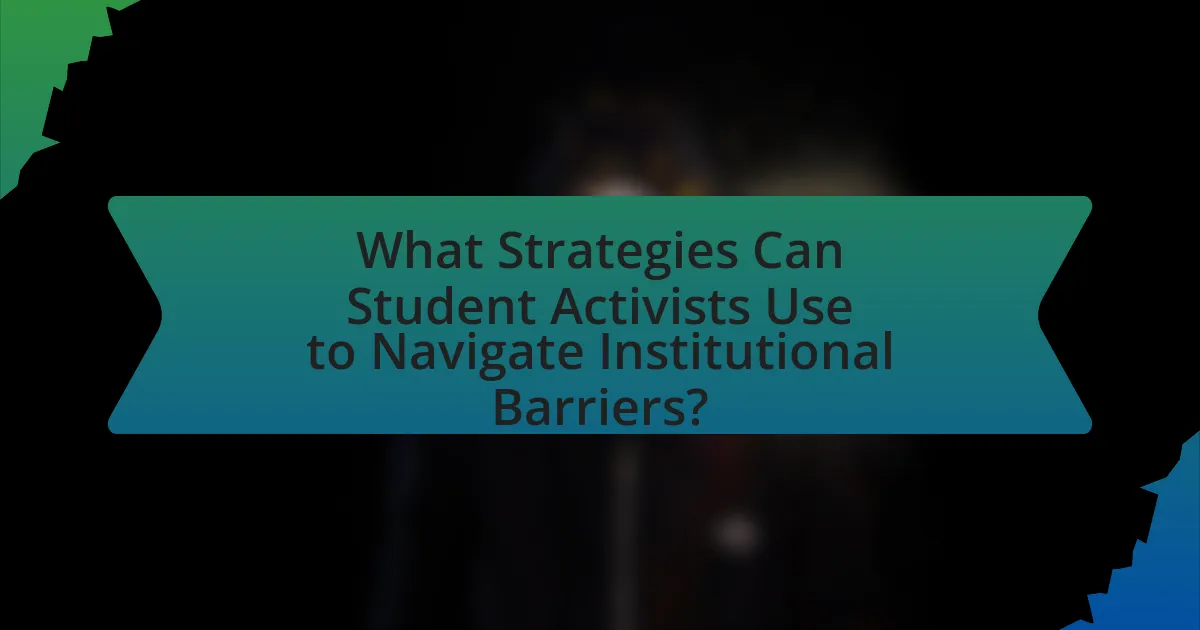
What Strategies Can Student Activists Use to Navigate Institutional Barriers?
Student activists can navigate institutional barriers by employing strategies such as building coalitions, utilizing data-driven advocacy, and engaging in strategic communication. Building coalitions with diverse groups enhances collective power and broadens support, as seen in movements like the March for Our Lives, which united students across various backgrounds to advocate for gun control. Utilizing data-driven advocacy involves gathering and presenting evidence to support claims, which can effectively persuade decision-makers; for instance, studies showing the impact of tuition hikes on student demographics can strengthen arguments for affordable education. Engaging in strategic communication, including social media campaigns and public demonstrations, allows activists to amplify their message and mobilize support, as demonstrated by the global reach of the climate strikes initiated by youth activists. These strategies collectively empower student activists to overcome institutional challenges and effect change.
How can student activists effectively communicate their needs?
Student activists can effectively communicate their needs by utilizing clear messaging, engaging in dialogue with stakeholders, and leveraging social media platforms. Clear messaging ensures that their demands are articulated in a straightforward manner, making it easier for decision-makers to understand and respond. Engaging in dialogue with stakeholders, such as university administration and faculty, fosters a collaborative environment where concerns can be addressed directly. Additionally, leveraging social media platforms allows activists to reach a broader audience, mobilizing support and raising awareness about their issues. Research indicates that effective communication strategies can significantly enhance the impact of advocacy efforts, as seen in the successful campaigns of various student organizations that have utilized these methods to influence policy changes.
What communication techniques can enhance advocacy efforts?
Effective communication techniques that can enhance advocacy efforts include storytelling, active listening, and clear messaging. Storytelling engages audiences emotionally, making complex issues relatable and memorable; for instance, personal narratives can illustrate the impact of policies on individuals, thereby fostering empathy and support. Active listening allows advocates to understand the concerns and perspectives of stakeholders, which can lead to more effective dialogue and collaboration. Clear messaging ensures that the core message is easily understood, which is crucial for mobilizing support and driving action; research shows that concise and focused communication increases the likelihood of audience engagement and retention.
How can storytelling be used to illustrate the impact of barriers?
Storytelling can effectively illustrate the impact of barriers by providing personal narratives that highlight individual experiences and challenges faced within institutional frameworks. These narratives allow audiences to connect emotionally with the struggles of others, making abstract concepts of barriers more tangible and relatable. For instance, a student activist might share their story of navigating bureaucratic obstacles to organize a campus event, demonstrating how these barriers hinder their efforts and affect their community. Research shows that storytelling can enhance empathy and understanding, as evidenced by studies indicating that narratives can lead to increased engagement and awareness about social issues (Green & Brock, 2000). This emotional connection fosters a deeper comprehension of the systemic barriers that exist, ultimately motivating others to advocate for change.
What are some practical approaches to overcoming barriers?
Practical approaches to overcoming barriers include building coalitions, utilizing effective communication strategies, and leveraging institutional resources. Building coalitions with like-minded individuals or organizations enhances collective strength and influence, as demonstrated by successful student movements that have mobilized diverse groups to advocate for change. Effective communication strategies, such as clear messaging and active listening, foster understanding and collaboration among stakeholders, which is crucial for addressing institutional resistance. Additionally, leveraging institutional resources, such as mentorship programs and administrative support, can provide essential guidance and facilitate access to decision-makers, thereby increasing the likelihood of overcoming obstacles.
How can student activists leverage existing resources and networks?
Student activists can leverage existing resources and networks by collaborating with established organizations, utilizing campus facilities, and engaging with faculty mentors. Collaborating with organizations such as student unions or advocacy groups provides access to funding, training, and a broader audience for their causes. Utilizing campus facilities, like meeting rooms and event spaces, allows activists to organize events and discussions effectively. Engaging with faculty mentors can offer guidance, credibility, and connections to external networks, enhancing the impact of their initiatives. These strategies are supported by the fact that student organizations often have established relationships with administration, which can facilitate smoother communication and support for activist efforts.
What role does persistence play in navigating institutional challenges?
Persistence is crucial in navigating institutional challenges as it enables individuals to overcome obstacles and achieve their goals despite resistance. When student activists face bureaucratic hurdles, persistent efforts can lead to gradual changes in policies or practices, as evidenced by historical movements where sustained advocacy resulted in significant reforms, such as the civil rights movement, which relied on continuous pressure to dismantle discriminatory laws. This unwavering commitment not only fosters resilience but also inspires others to join the cause, amplifying the collective impact on institutional change.
What best practices should student activists follow when facing barriers?
Student activists should prioritize collaboration, strategic communication, and resilience when facing barriers. Collaboration with diverse groups enhances support and resources, as seen in successful movements like the Civil Rights Movement, where coalitions across various demographics strengthened their cause. Strategic communication involves clearly articulating goals and utilizing multiple platforms to reach wider audiences, which has proven effective in campaigns such as the March for Our Lives. Resilience is crucial, as persistence in the face of setbacks can lead to eventual success, evidenced by the sustained efforts of activists in the rights movement, which ultimately resulted in significant legal advancements.
How can students maintain resilience in the face of challenges?
Students can maintain resilience in the face of challenges by developing a strong support network and practicing adaptive coping strategies. Research indicates that social support significantly enhances resilience, as students who engage with peers, mentors, and family are better equipped to handle stressors (Taylor et al., 2017, Journal of Educational Psychology). Additionally, employing techniques such as mindfulness, goal-setting, and positive self-talk can help students navigate difficulties effectively. Studies show that these strategies not only improve emotional regulation but also foster a growth mindset, enabling students to view challenges as opportunities for learning and development (Dweck, 2006, Mindset: The New Psychology of Success).
What are the key lessons learned from successful student activism?
Successful student activism teaches the importance of organization, clear communication, and coalition-building. Organized efforts, such as the 2018 March for Our Lives, demonstrated that a unified group can effectively advocate for policy changes, as seen in the push for gun control legislation. Clear communication ensures that messages resonate with both peers and decision-makers, exemplified by the use of social media campaigns that amplify student voices. Additionally, building coalitions with other groups, like environmental or social justice organizations, enhances the impact of activism, as evidenced by the collaboration during the 2019 Global Climate Strike, which united diverse student bodies to address climate change. These lessons highlight the effectiveness of strategic planning and collaboration in overcoming institutional barriers.
What tips can help student activists effectively navigate institutional barriers?
Student activists can effectively navigate institutional barriers by building coalitions, understanding institutional policies, and utilizing strategic communication. Building coalitions with diverse groups enhances collective power and broadens support, as seen in successful movements like the Civil Rights Movement, where collaboration among various organizations strengthened their impact. Understanding institutional policies allows activists to identify leverage points for change; for example, knowing the specific procedures for submitting proposals can increase the likelihood of approval. Strategic communication, including clear messaging and targeted outreach, ensures that the activist’s goals resonate with both the student body and administration, as demonstrated by the successful campaigns of student-led organizations that effectively articulated their demands.

